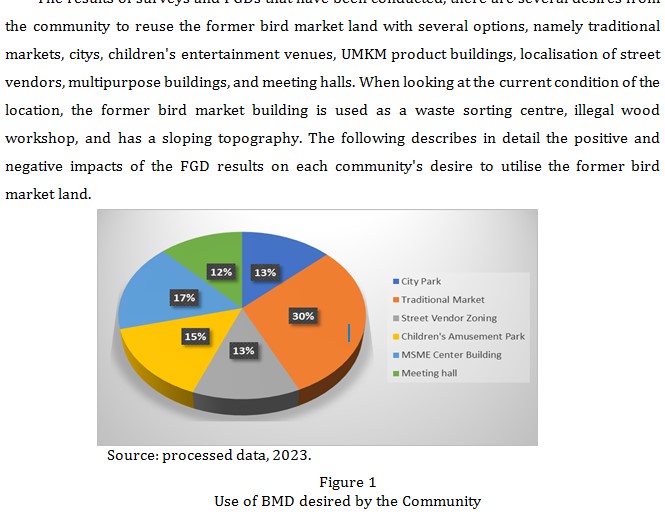Utilizing Ex-Bird Market Buildings in the City of Balikpapan: Needs and Economics Approach Analysis
DOI:
https://doi.org/10.12928/jampe.v2i2.7773Keywords:
Asset, Optimization , Utilization, Economic NeedsAbstract
Balikpapan City has many active markets but there are also markets
that are no longer active, one of which is the former Bird Market
building. The purpose of this study is to analyse the needs and
economics of the asset in order to achieve the most optimal
management. Alternative economic studies are based on the results of
FGDs and surveys to fulfil the wishes of the community. The data used
is primary data using a survey where the respondents are the
community around the asset location and supported by stakeholders.
The analytical tools used are BCR (Benefit Cost Ratio) and NPV (Net
Present Value). The results obtained are the most profitable
alternative economic use is a children's amusement park with an NPV
value of -19.6 billion rupiah and a BCR value of 1.71, followed by the
UMKM Center building with an NPV value of 3.3 billion rupiah and a
BCR value of 1.17 or more than 1. Meanwhile, the first priority of
community needs is the traditional market, the second is the UMKM
center building. So the alternative that suits the needs of the
community and has economic benefits is the UMKM centre building.
Therefore, based on the results of economic calculations, it is
recommended that the former bird market building be better used for
the UMKM centre. Thus, the local government can use this research as
a reference in determining the reuse of the former bird market
building.
References
Aprilian, R. D., & Widiastuti, I. (2021). The Story of Adaptive Reuse in Jakarta's Old Building Under the 'Instagrammable' Era. Advances in Social Science, Education and Humanities Research, 602, 172-179. doi:http://dx.doi.org/10.2991/assehr.k.211126.019
Bassal, C., & Khalifa, M. (2022). Adaptive Reuse of Abandoned Buildings as A Means of Improving Livability. Architecture and Planning Journal (APJ), 28(2), 1-20. doi:https://doi.org/10.54729/ZXZP6273
Cascone, S., & Sciuto, G. (2018). Recovery and reuse of abandoned buildings for student housing: A case study in Catania, Italy. Frontiers of Architectural Research, 7(4), 510-520. doi:http://dx.doi.org/10.1016/j.foar.2018.08.004
Fontan-Vela, M., Rivera-Navarro, J., Gullon, P., Diez, J., Anguelovski, I., & Franco, M. (2021). Active use and perceptions of parks as urban assets for physical activity: A mixed-methods study. Health and Place, 71, 1-10. doi:https://doi.org/10.1016/j.healthplace.2021.102660
IAM, T. I. (2015). Asset Management: An Anatomy (3 ed.).
Isnaini, N., Ujianto, H., & Yuhertiana, I. (2020). Optimizing the Use of Government Assets: A Case Study in the Regional Government of East Java Province. Untag, 1-15.
Kesumasari, D. (2020). Understanding physical settings of street vendors in Surakarta, Indonesia. IOP Conf. Series: Earth and Environmental Science, 490, 1-15. doi:10.1088/1755-1315/490/1/012002
Konakoglu, S. S., Demirel, Ö., & Çelik, K. T. (2021). A Research on the Usage Reasons of Urban Parks: A Case Study of Amasya Courthouse Urban Park. Mehmet Akif Ersoy Üniversitesi Fen Bilimleri Enstitüsü Dergisi, 12(1), 18-30. doi:http://dx.doi.org/10.29048/makufebed.846927
Misirlisoy, D. (2020). Towards Sustainable Adaptive Reuse of Traditional Marketplaces. The Historic Environment Policy & Practice, 12(1), 1-17. doi:http://dx.doi.org/10.1080/17567505.2020.1784671
Murni. (2017). Pemanfaatan Aset Tanah Milik Pemerintah Daerah Untuk Meningkatkan Pendapatan Asli Daerah di Kabupaten Berau. Jakarta: Universitas Terbuka.
Mutmainah, N., Jaunyri, & Hijri. (2018). Pengelolaan Aset Tanah Milik Pemerintah Daerah (Studi Pada Dinas Pengelola Pendapatan Keuangan dan Aset Daerah Kabupaten Bima. PP Keuangan, 1-20.
Ngwira, M., & Manase, D. (2016). Public Sector Property Asset Management. Wiley Blackwell: John Wiley & Sons, Ltd.
Nurfindarti, E., Ausi, S., & Gandakusumah, N. L. (2020). The new of Pasar Lama : new design with new normal life concept. IOP Conference Series Earth and Environmental Science, 592(1), 1-15. doi:http://dx.doi.org/10.1088/1755-1315/592/1/012035
O'sullivan, A., & Sheffrin, S. M. (2021). Economics: Principles in Action. Washington DC: Pearson Prentice Hall.
Panggabean. (2002). Kasus Aset Yayasan dan Alternatif Penyelesaian Sengketa. Jakarta: Pustaka Sinar Harapan.
Park, S., Park, S. I., & Lee, S. H. (2016). Strategy on Sustainable Infrastructure Asset Management: Focus on Korea's Future Policy Directivity. Renewable and Sustainable Eenergy Reviews, 6(2), 710-722.
Riyono, S. (2013). Pemanfaatan Aset Daerah (Studi Tentang Pola Kemitraan Aset Tanah Pemerintah Provinsi Jawa Timur). Jurnal Administrasi Publik, 11(2), 237-245.
Siregar, D. (2004). Management Aset Strategis Penataan Konsep Pembangunan Berkelanjutan Secara Nasional dalam Konteks Kepala Daerah Sebagai CEO's Pada Era Globalisasi dan Otonomi Daerah. Jakarta: Gramedia Pustaka Utama.
Sugiama, G. (2013). Manajemen Aset Pariwisata. Bandung: Guardaya Intimarta.
Tumija. (2022). The Role of Government and Community Participation in Improving Micro, Small, and Medium Enterprises (UMKM) During The Covid-19 Pandemic in Cipageran, Cimahi. Civitas Consecratio, 2(1), 25-37. doi:https://doi.org/10.33701/cc.v2i1.2328
Wahadamaputera, S., & Permata, D. D. (2019). A Choice between Being Conserve or Demolish: First Baptist Church Building Bandung. Indonesian Journal of Built Environmental & Sustainability, 1(2), 54-61.

Downloads
Published
Issue
Section
License
Copyright (c) 2023 Zahrul Azhar bin Nasir, Anisa Nurpita, Agusta Ika Prihanti Nugraheni

This work is licensed under a Creative Commons Attribution-ShareAlike 4.0 International License.










